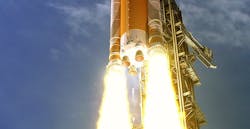Designing a custom large-scale helium reclamation system for NASA’s Space Launch System
By Brad Wallace, Applications Engineer, Engineering Solutions Group, Airgas Inc.
and Bret Shelton, Space Product Group Director, VACCO Industries
In 2013, VACCO Industries – a specialty aerospace valve manufacturer company based in South El Monte, California – was contracted by Boeing to design and produce custom regulators and relief valves to control the flow of helium in NASA’s Space Launch System (SLS). With 60 years of experience engineering and manufacturing components for space applications, VACCO had worked closely with NASA on a wide range of projects over the years. However, this particular project proved to be unique, both in scale and in the challenges it presented.
Testing for an SLS critical component
The regulators that VACCO manufactured for the SLS are used to purge the main rocket engines with helium before takeoff, while the relief valves provide a safe backup to prevent over-pressurization. Both components are critical to the success of the rocket, and therefore needed to undergo rigorous testing before they could be delivered to Boeing, and ultimately, NASA.
VACCO was able to use nitrogen in early-phase testing of the components, but the final acceptance phase of testing — which ensures that VACCO’s products met the Boeing specification — necessitated that helium be used. This presented several challenges.
The first challenge was the enormous volume of helium needed to conduct testing. Helium is one of the few elements that escapes gravity to space, meaning once it is exhausted into the atmosphere, it is lost forever. During acceptance testing, approximately 250,000 standard cubic feet (scf) of helium are used per valve. The large volume of helium required for the testing would require delivery of two semi-trucks of helium every week for one year. Four of these trailers would be required on-site to maintain a ready source for testing. Compounding the challenge were concerns over fluctuating global helium supplies, as well as the cost to secure such a large volume of the gas.
Recycling and purifying large volumes of helium
There was one ideal solution to ensure VACCO had enough helium to test its components for the high stakes project: utilize a helium reclamation system. Helium reclamation is a process that captures and purifies helium exhausted from a process to a specified purity level and compresses it to a usable pressure for a specific process. The solution would not only provide VACCO with a steady stream of the gas, therefore mitigating the risk of test delays due to helium supply fluctuations, but it would also provide significant long-term savings by reclaiming the helium for reuse.
The only problem? A reclamation system of the size and capacity needed for this volume of helium creates many tough design challenges. VACCO turned to Airgas Inc.'s Engineering Solutions Group, which specializes in scalable, custom engineered solutions for helium and other industrial and specialty gases. Over the course of about six months, Airgas worked with VACCO to design what became the largest helium reclamation system Airgas has built.
In fact, it was so big that questions arose over where the system (approximately the size of a semi-trailer) and its massive recovery bag, which collects the reclaimed helium after used in the process, would be housed. A typical recovery bag is housed in the ceiling of the facility, but for this bag, at 60 feet long by 20 feet wide by 30 feet tall — and made of a dense, rubber-like material to reduce helium permeation — the ceiling wasn’t a viable option.
Storing the bag on the roof of a facility wouldn’t work either, as there were concerns over it breaking loose and floating away, or deteriorating from exposure to the outdoor elements. Instead, a custom building was designed and built at the customer’s facility in Southern California to house both the system and the recovery bag.
Beyond these logistics, Airgas faced even greater challenges in the design of the system, which needed to:
▪ Store the helium at 6,000 psi — double the normal pressure of traditional high pressure storage vessels;
▪ Maintain 99.999% helium purity – levels that are challenging to achieve even in a lab setting;
▪ Accomplish a helium recovery rate of 100 standard cubic feet per minute (scfm)
▪ Operate automatically, with little manual maintenance and operator involvement required.
How the system works
The reclamation system that Airgas designed is based on filtration of large particles, cryogenic cooling of the gas to remove organic compounds and moisture, and finally, a cryogenic molecular sieve to remove the last of the unwanted gasses. The system is completely automated, controlled by a programmable logic controller which detects the level of helium collected in the atmospheric recovery bag. Sensors detect the height of the bag and start the purifier cooling sequence automatically. The cooling sequence fills the pre-cooler and molecular sieve dewar with liquid nitrogen (approximately -320 degrees Fahrenheit) in preparation for purification operations.
When the plant is sufficiently cooled and ready for helium purification, the helium is pulled from the collection bag by process compressors and directed into the pre-cooler for moisture removal. As the helium cools, condensable contaminants, such as water and hydrocarbons physically drop to the bottom of the pre-cooler where they remain until system regeneration.
The gaseous helium — now less the condensables — continues to the second stage of the purifier, which is packed with a proprietary sieve material that captures most atmospheric contaminants, such as nitrogen, oxygen, argon, with the exception of helium, hydrogen and neon. The efficiency of the sieve material is greatly improved by cryogenic temperatures. The relatively large diameter of the purifier allows for proper residence time between the helium and the sieve material. Helium flows out of the bottom of the purifier and is piped through tubing while immersed in liquid nitrogen. This insures that the helium is as cold as possible for maximum cooling effect to the incoming helium. The purified helium exits at the top of the purifier being coiled with the incoming helium tubing, which slightly warms the exiting purified helium and cools the incoming contaminated helium improving the efficiency of the purifier and reduces the use of liquid nitrogen.
The outcome
Airgas completed installation of the reclamation system in March 2014 and it is currently being used by VACCO in ongoing testing of its components for the SLS. As the system runs, the purity of the helium is monitored at four locations throughout the plant, and periodic samples are tested by an outside lab for verification.
The system continues to exceed the operating requirements it was designed to accomplish, including delivering a recovery efficiency of 90 percent or greater. Thanks to the system’s efficiency, VACCO has already seen a return on the investment in the reclamation system and plant, and expects to obtain a full return within their capital recovery guidelines.
The project has proven the value of reclamation systems for high-volume helium testing, and in a larger sense, offers a small window into the wide breadth of challenges that are being overcome every day by companies across the U.S. and around world in the name of space exploration.
The authors
Brad Wallace is an applications engineer for Airgas Inc.’s Engineering Solutions Group based in Cleveland, Ohio, and was a part of the team responsible for designing and building the helium reclamation system for VACCO Industries. He can be reached at [email protected]. Airgas, Inc. (www.Airgas.com), through its subsidiaries, is one of the nation's leading suppliers of industrial, medical and specialty gases, and hardgoods, such as welding equipment and related products.
Bret Shelton is the Space Products Group Director for VACCO Industries. He started the Helium Project while Program Manager for Helium Valves. Bret can be reached at [email protected].
VACCO produces space, naval, and aircraft valves and filters for US and foreign customers. VACCO Industries, a subsidiary of ESCO Technologies Inc. (NYSE: ESE) part of the Filtration Solutions Group, is a designer and manufacturer of specialty valves, filters, and advanced fluid control products. For 60 years, VACCO has been serving the defense, space and commercial markets to provide innovative, engineered solutions to critical missions. For more information about VACCO products, visit www.vacco.com or contact: John A. Habis, Vice President, Business Development & Strategy (626) 443-7121.
Intelligent Aerospace, Global Aerospace Technology Network
Intelligent Aerospace, the global aerospace technology network, reports on the latest tools, technologies, and trends of vital importance to aerospace professionals involved in air traffic control, airport operations, satellites and space, and commercial and military avionics on fixed-wing, rotor-wing, and unmanned aircraft throughout the world.
You might also like:
Subscribe today to receive all the latest aerospace technology and engineering news, delivered directly to your e-mail inbox twice a week (Tuesdays and Thursdays). Sign upfor your free subscription to the Intelligent Inbox e-newsletter at http://www.intelligent-aerospace.com/subscribe.html.
Connect with Intelligent Aerospace on social media: Twitter (@IntelligentAero), LinkedIn,Google+, and Instagram.




